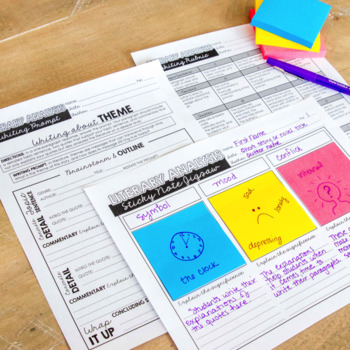Analyzing theme is an essential part of reading literature in the classroom. It not only allows the story to be understood more by the students, but the students can also relate the story to their own lives and other literature they have read. Here are four ways in which students can begin to analyze the theme of the literature they read:
1. Look for recurring images.
Students can easily analyze theme through the repeated images and other motifs throughout the novel. Once students identify the theme, the recurring images can also be used to explain what this theme might mean. If there are a lot of images representing sadness, like cloudy days or gray colors, the reader can extrapolate more of what this means to the overall story. The repeating images could add up to the smaller themes, and then the student can link them back to the overall theme analysis.
2. Ask questions (and make a note of them)
Questions are sure to come up when trying to analyze theme, and while reading novels in general, and it is best to use these questions to further the analysis. Having students question what they read is a great skill for students to master, and will only allow for a more in-depth analysis. For example, if the images are dark and depressing, the student could question why this is. What does this bring to the story? It also is important to write these questions down, to link all the questions when analyzing the entire theme of the novel. Another question to ask is, why this theme is essential to the story?
3. Identify the different tools the author uses to express the theme.
Different literary devices are essential to the theme, and the ones the author selects are there for a reason. To understand the theme of the story even more so, analyzing the specific literary devices is an integral part of the analysis. The devices add layers to the theme, and once students take notice of them and look closer, the analysis will only be the better for it. An example of what a student could notice in literary devices would be multiple mentions of metaphors, and as the last way suggested, they could ask questions about this. Why are there multiple metaphors throughout the story? What does that mean for the overall theme?
4. Keep a notebook of notes while reading, and then compare all once finished reading.
One of the best ways to read a book while trying to analyze different aspects of it, theme specifically, is to keep notes of what you’re reading so you can understand the specifics of it. This allows the reader to see the similarities and differences from throughout the book that he or she wrote while in the midst of reading, that maybe he or she wouldn’t have noticed if it was not written down. Things to make a note of are character traits, literary devices, passages the reader likes, imagery, and exciting plot points.
The theme is one of the most critical aspects of any literary work. So analyzing theme in the classroom is one of the most important parts of studying literature. These were just a few ways to introduce analyzing theme in your classroom that students should find interesting and helpful in their work.
Resources to Help Teach and Analyze Theme:




